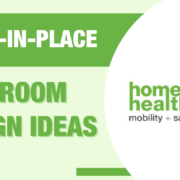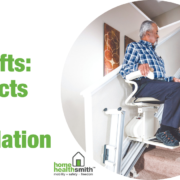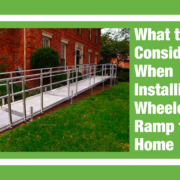Room-by-Room Checklist for Safely Aging in Place
As the National Institute on Aging rightly points out, most Americans want the same things as they get older. These adults want to:
- Stay in their own homes
- Maintain their independence as long as possible
- Be able to turn to family and friends for assistance when needed
In other words, folks prefer to “age in place.”
That being said, the home can be a potentially dangerous place for adults with mobility issues. Each interior room, entryway, and exterior area can pose unique challenges when it comes to potential fall risks and general safety concerns.
If you’re an aging senior or are entrusted to provide care for one, it’s a smart idea to do a walkthrough of every room of the home with a safety checklist in hand.

Ultimate Checklist for Safely Aging in Place
At Home Healthsmith, we believe seniors and others with accessibility or mobility issues should be able to age safely in the comfort of their own homes. And that’s why we’ve come alongside to provide you with a helpful room-by-room safety checklist.
Entryways and Exits
The AARP recommends you create at least one no-step entry into the home. Vertical platform lifts or wheelchair ramp installation can also be helpful solutions for making the entrance more accessible. Including a covered entryway for protection from the elements is also a good idea.
Make sure all entryways and exits are well-lit. Keep the area clear of any tripping hazards, and also consider placing a bench in the foyer for sitting whenever putting on or taking off shoes.
Living Room
Take a survey of the living room area, and map out a path for the easiest navigation. Determine which furniture is essential, and then declutter to get rid of any items that may impede travel or pose potential tripping hazards.
Look at the floor, too. Keep power cords out of the way, and ensure that any area rugs include traction backing so they’ll stay in place.
Kitchen
Cooking safety is obviously paramount. Choose a stove that provides notification whenever a burner is on or if a surface is hot.
There are other safety and mobility issues to consider in the kitchen, too. Adjust the location of any major appliances to make sure they’re simple to navigate. Choose refrigerator doors and handles that are within easy reach of a wheelchair or other mobility device.
Also, consider placing slide-out drawers or trays into any cabinets for better accessibility.
Bathroom
More than two-thirds of home-related injuries that require ER visits occur in the bathroom, so you need to be especially careful here. Start with:
- Adequate lighting
- Non-slip floors
- Easily accessible storage space
There are also many specific bathroom safety worth installing, including grab bars, shower seats & chairs, handheld shower nozzles, locking transfer benches, and toilet seats, risers, & frames.
Bedroom
If the bedroom is currently upstairs, consider moving it down to the main level for easier access. Make sure the bed is easy to get in and out of; specialized home lifts can be installed for this purpose.
Bed rails can be added for safety, and make sure any nightstands match the height of the bed. You also might consider investing in an adjustable bed for added comfort.
Hallways and Staircases
Ensure that hallways are wide enough to accommodate wheelchairs, walkers, or similar mobility devices. Swap out lever handles for doorknobs on all interior doors. These are much easier to use for folks who have limited mobility, or who may suffer from arthritis.
Staircases should be equipped with sturdy handrails at a minimum, and carpeted stairs provide more grip than hardwood or smooth flooring. Powered stairlifts or residential elevators can also be installed to make upper floors even more accessible.
Outdoor Areas
Even if your outdoor areas are wide-open spaces, that doesn’t necessarily mean they’re safe and accessible. For example, you may have a senior who loves gardening, but simply can’t bend down to work in the flowers anymore. The solution? Put up some raised garden boxes that are easier to reach from a seated position.
For outdoor navigation by wheelchair, walker, or rollater, create an accessible path of travel that doesn’t include gravel or uneven surfaces, including grass. Also, consider installing outdoor floodlights with automatic light/motion sensors.

Trust Home Healthsmith for Help Safely Aging in Place
We hope you find this room-by-room checklist to be helpful. If you’re not sure about the next step or have other questions, feel free to reach out to us at Home Healthsmith.
If you’re in Massachusetts, Rhode Island, or Connecticut, one of our trained experts can come out and conduct a SafeHome Audit to identify safety and accessibility opportunities. We can also provide a free estimate for any suggested upgrades.
Home Healthsmith is proud to offer the best aging-in-place products, plus we install everything we sell. Our professional installation process makes everything smooth and painless, and we’ll even check back to make sure everything is running smoothly for you.
Get in touch to schedule your free consultation today!










